10 — 1 Accounts Receivable Management 10

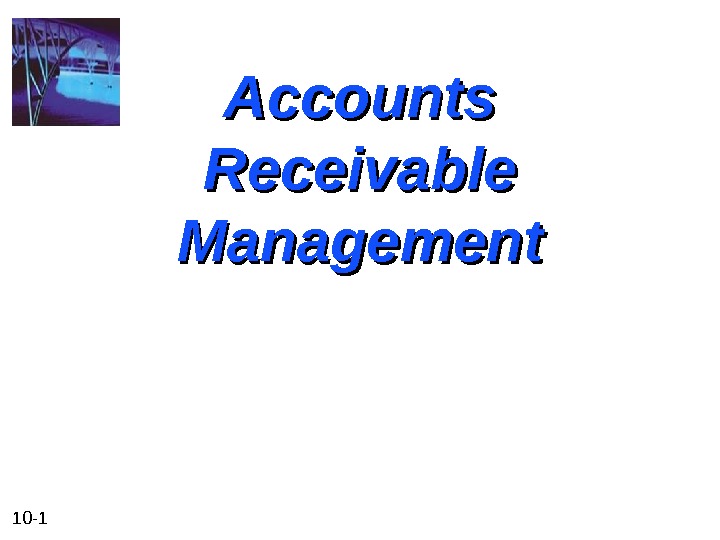
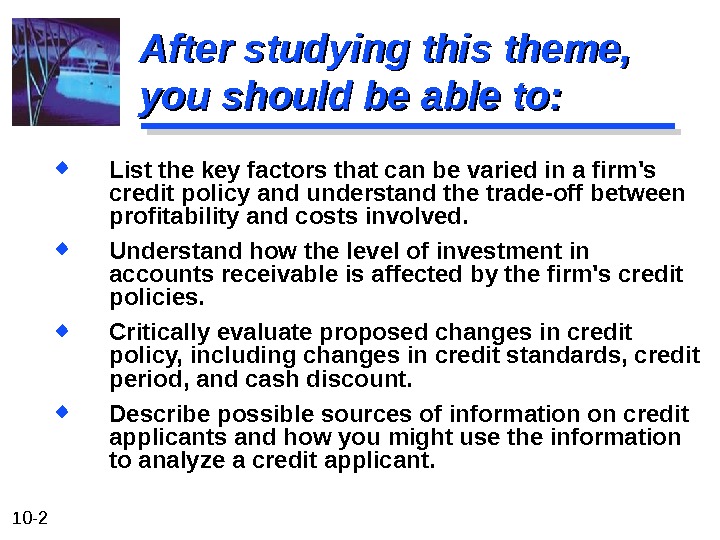
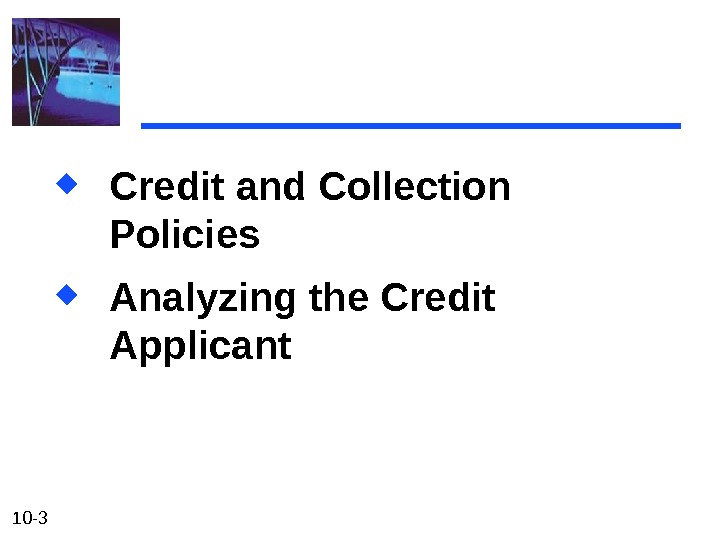
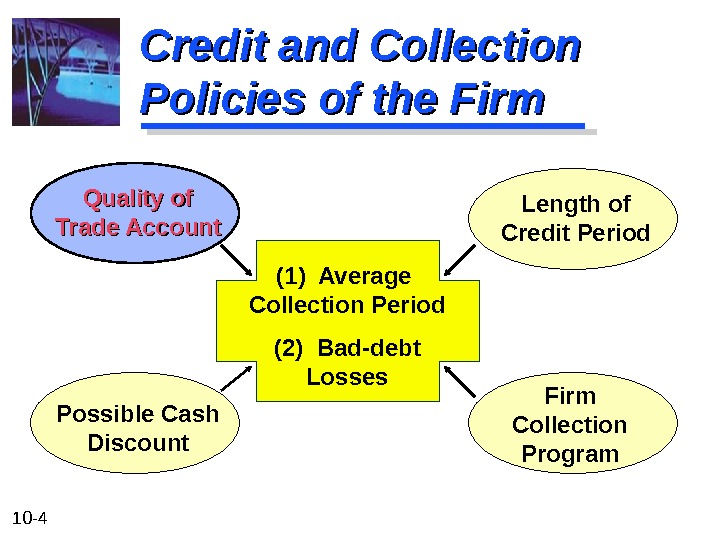
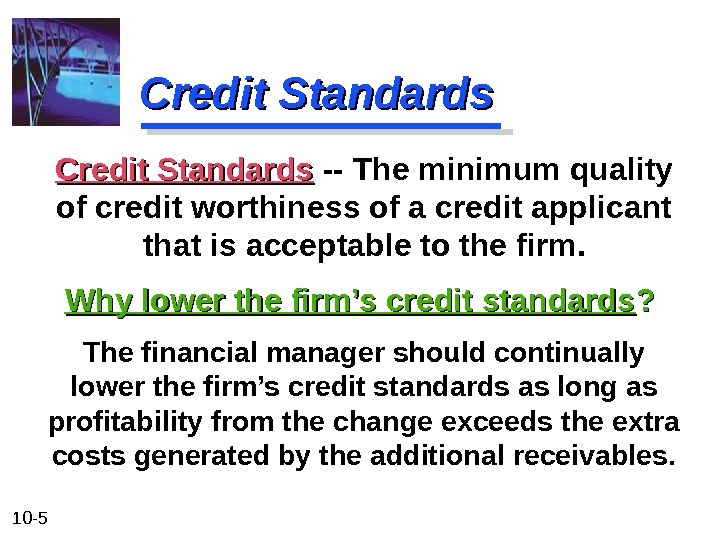

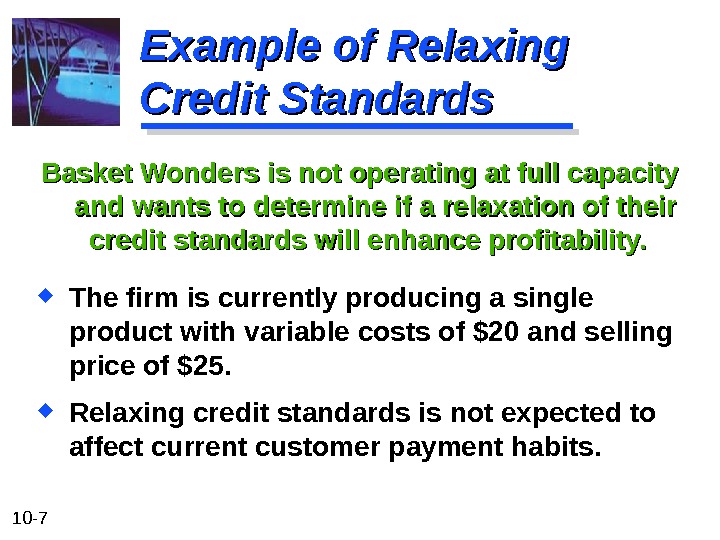
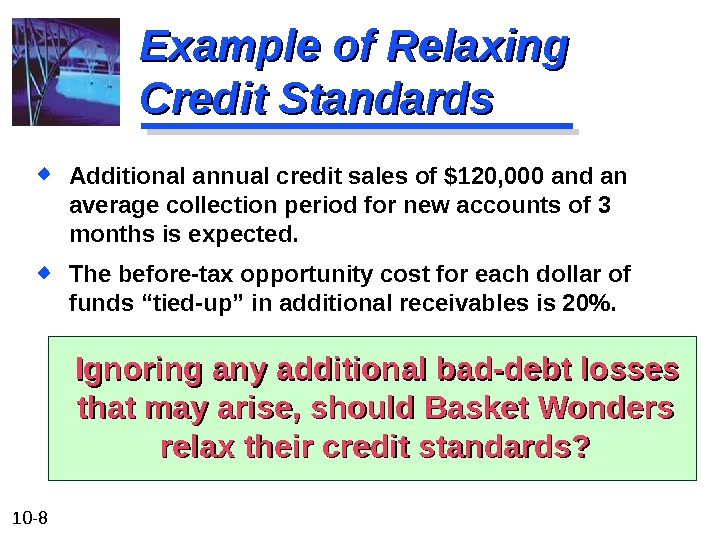
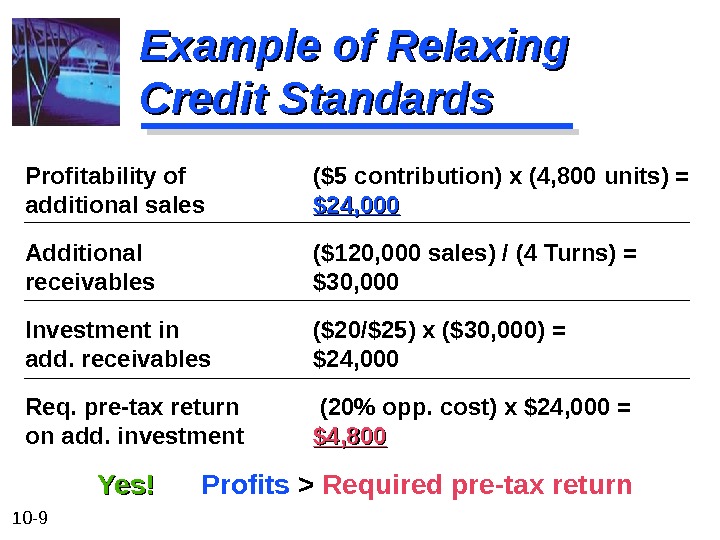
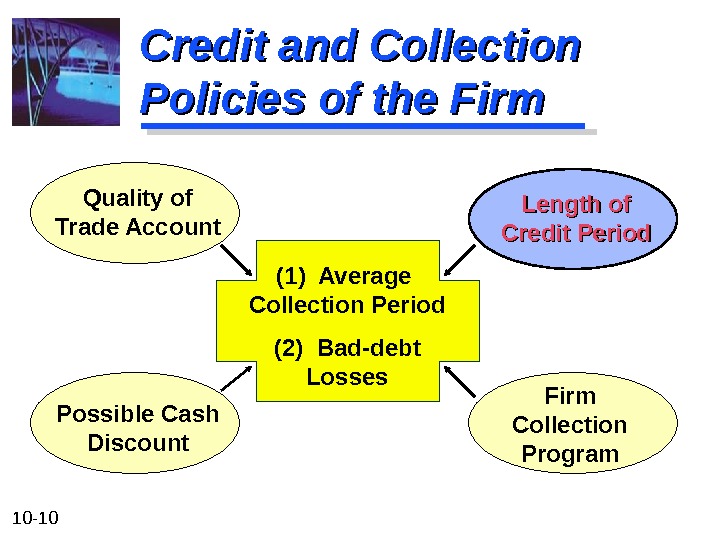
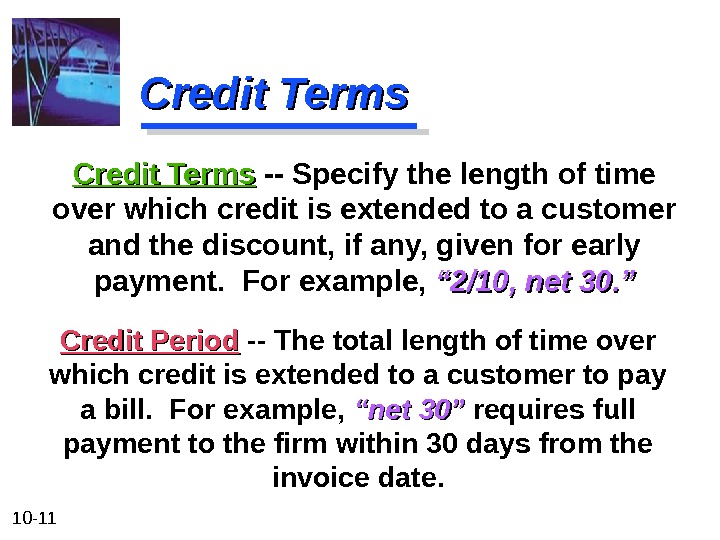
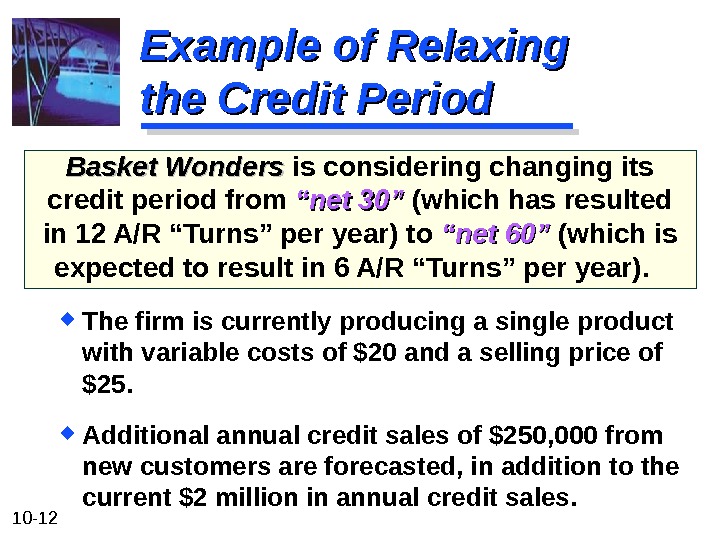
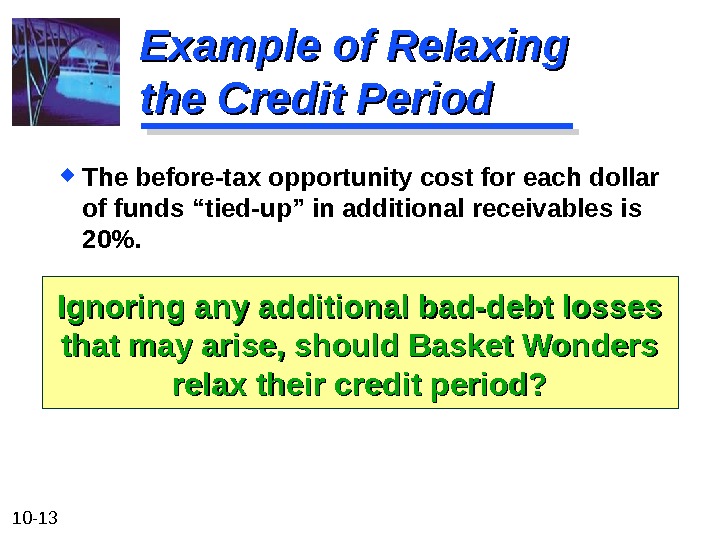
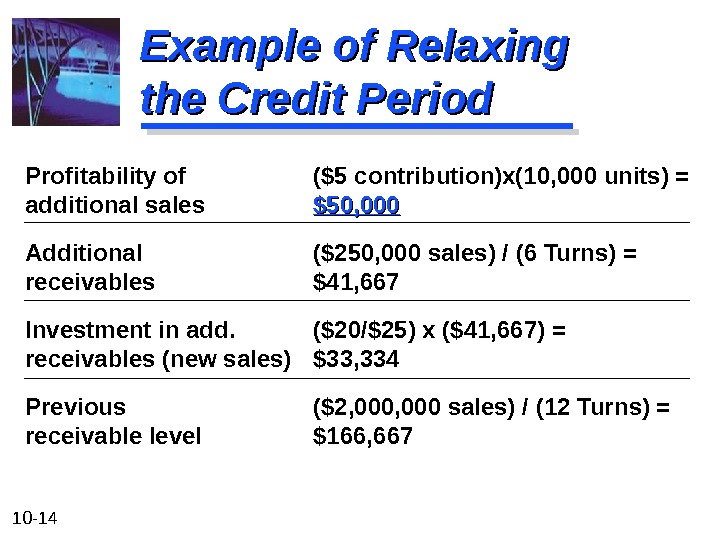
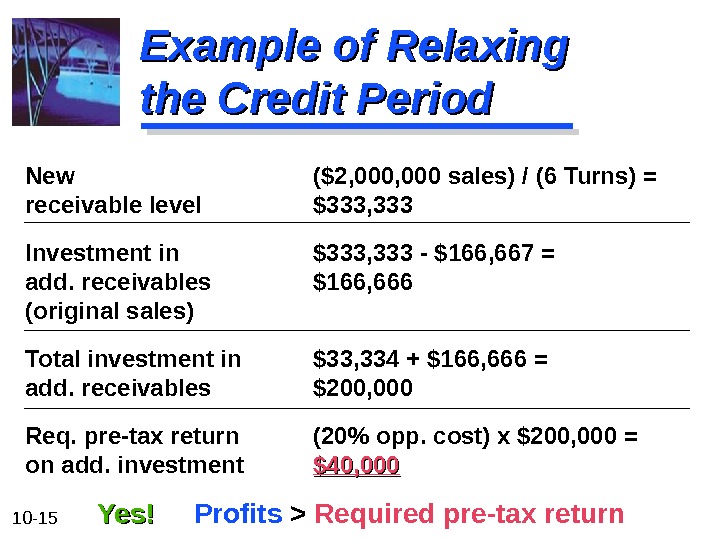
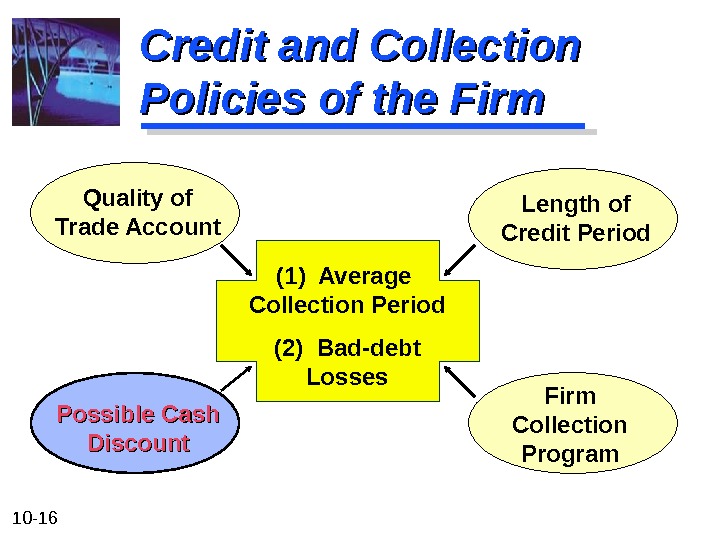
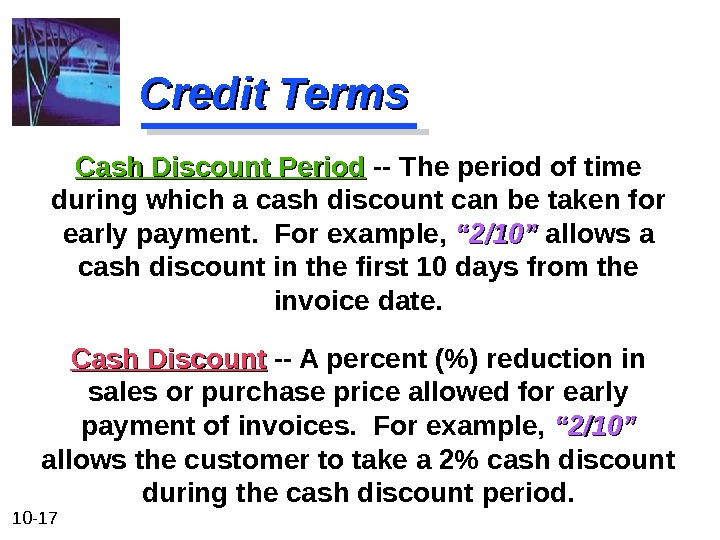
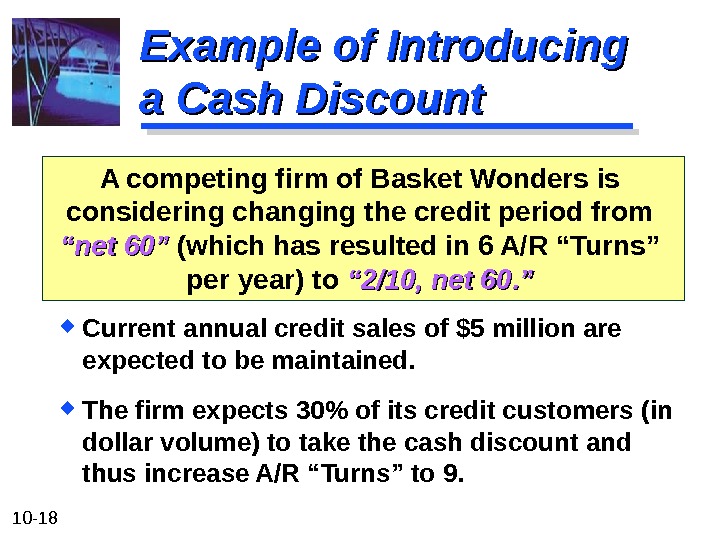
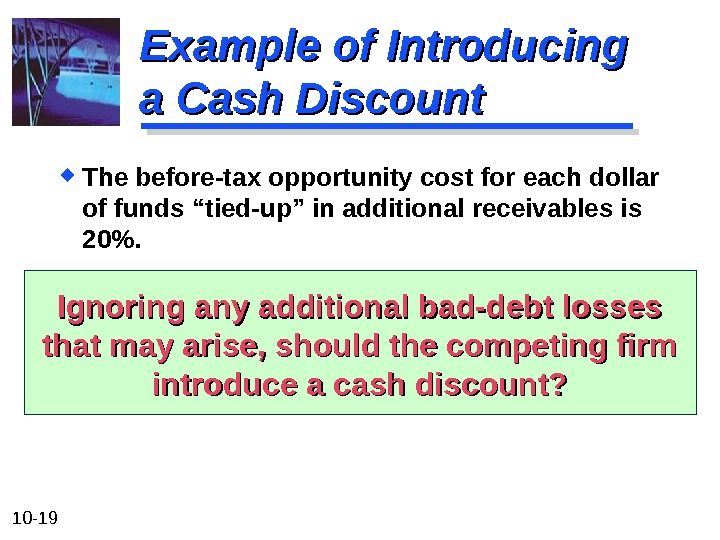
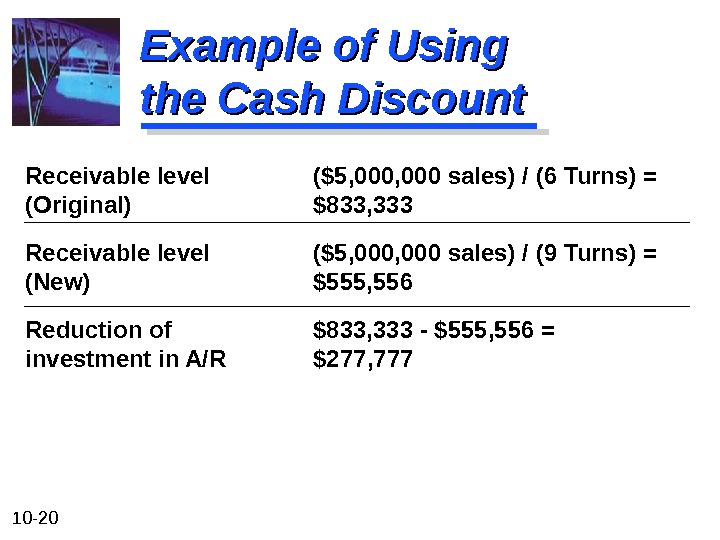

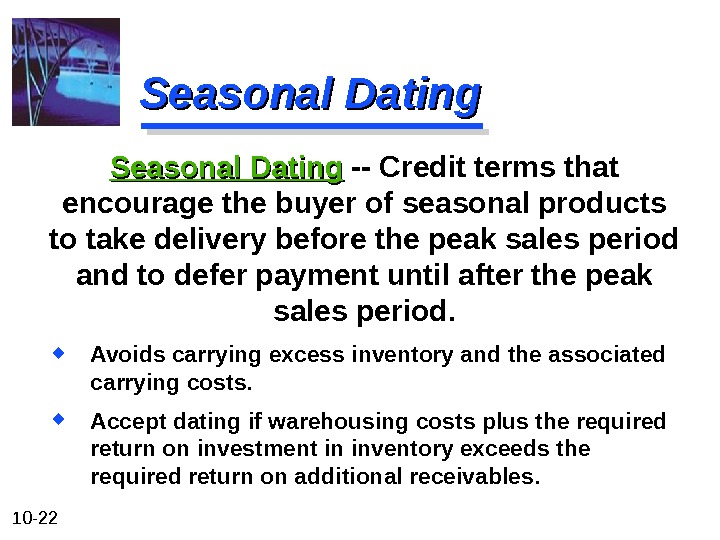
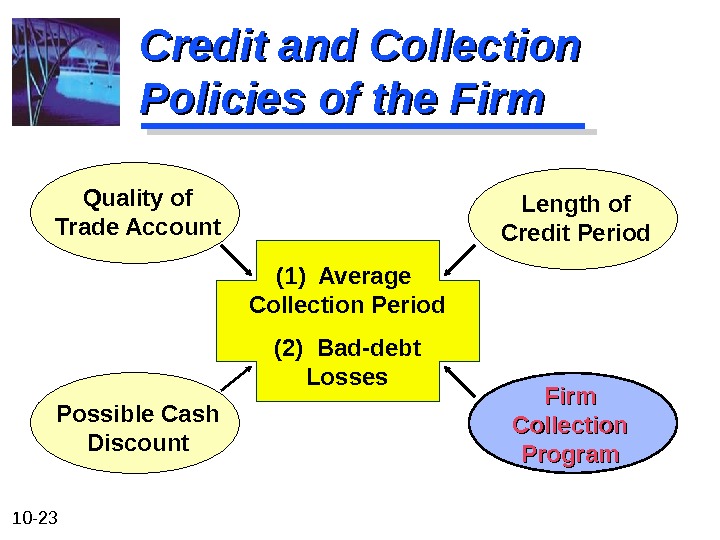
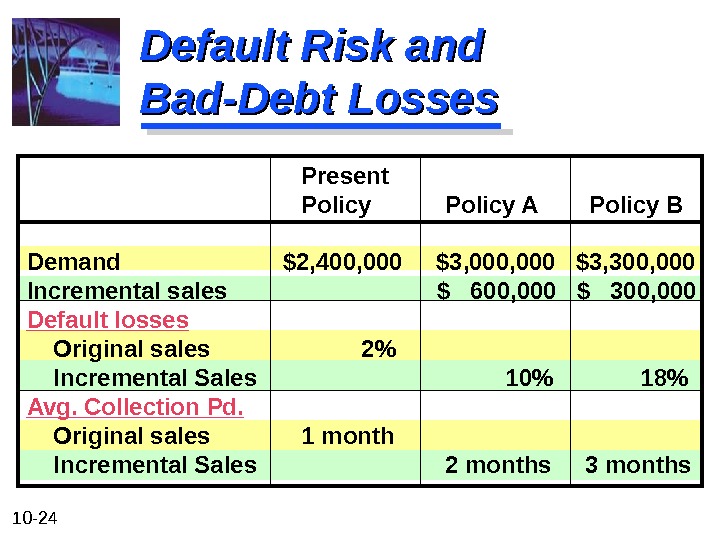
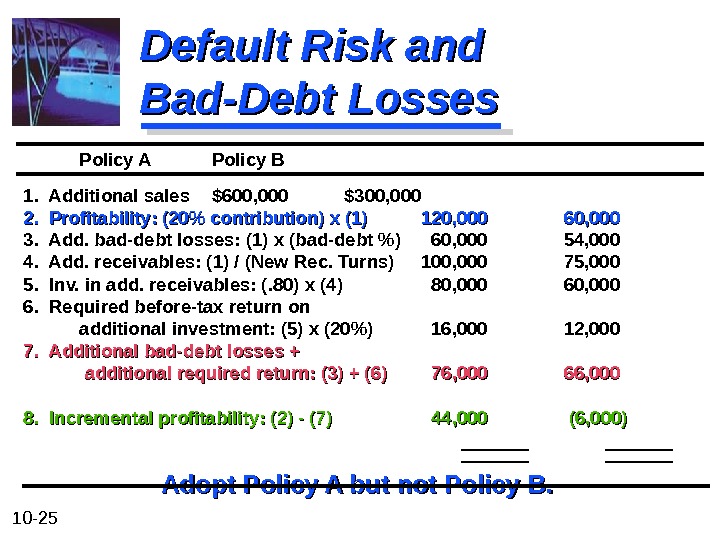
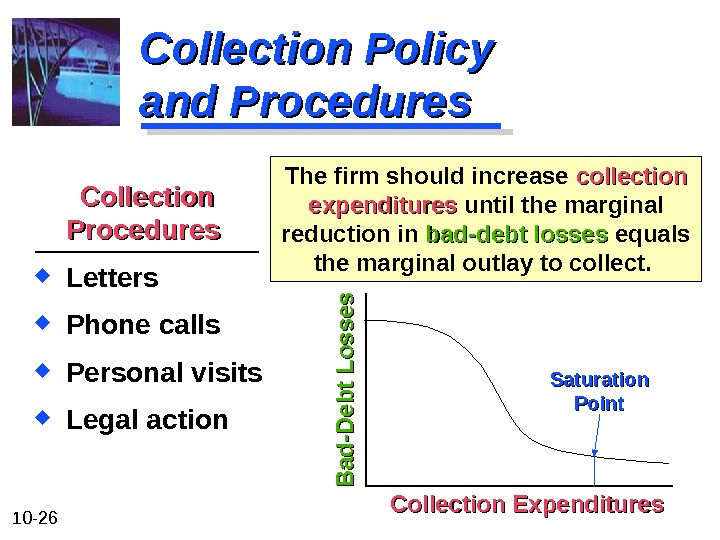
- Размер: 615.5 Кб
- Количество слайдов: 26
Описание презентации 10 — 1 Accounts Receivable Management 10 по слайдам
 10 — 1 Accounts Receivable Management
10 — 1 Accounts Receivable Management
 10 — 2 After studying this theme, you should be able to: List the key factors that can be varied in a firm’s credit policy and understand the trade-off between profitability and costs involved. Understand how the level of investment in accounts receivable is affected by the firm’s credit policies. Critically evaluate proposed changes in credit policy, including changes in credit standards, credit period, and cash discount. Describe possible sources of information on credit applicants and how you might use the information to analyze a credit applicant.
10 — 2 After studying this theme, you should be able to: List the key factors that can be varied in a firm’s credit policy and understand the trade-off between profitability and costs involved. Understand how the level of investment in accounts receivable is affected by the firm’s credit policies. Critically evaluate proposed changes in credit policy, including changes in credit standards, credit period, and cash discount. Describe possible sources of information on credit applicants and how you might use the information to analyze a credit applicant.
 10 — 3 Credit and Collection Policies Analyzing the Credit Applicant
10 — 3 Credit and Collection Policies Analyzing the Credit Applicant
 10 — 4 Credit and Collection Policies of the Firm (1) Average Collection Period (2) Bad-debt Losses. Quality of Trade Account Length of Credit Period Possible Cash Discount Firm Collection Program
10 — 4 Credit and Collection Policies of the Firm (1) Average Collection Period (2) Bad-debt Losses. Quality of Trade Account Length of Credit Period Possible Cash Discount Firm Collection Program
 10 — 5 Credit Standards The financial manager should continually lower the firm’s credit standards as long as profitability from the change exceeds the extra costs generated by the additional receivables. Credit Standards — The minimum quality of credit worthiness of a credit applicant that is acceptable to the firm. Why lower the firm’s credit standards ? ?
10 — 5 Credit Standards The financial manager should continually lower the firm’s credit standards as long as profitability from the change exceeds the extra costs generated by the additional receivables. Credit Standards — The minimum quality of credit worthiness of a credit applicant that is acceptable to the firm. Why lower the firm’s credit standards ? ?
 10 — 6 Credit Standards A larger credit department Additional clerical work Servicing additional accounts Bad-debt losses Opportunity costs Costs arising from relaxing credit standards
10 — 6 Credit Standards A larger credit department Additional clerical work Servicing additional accounts Bad-debt losses Opportunity costs Costs arising from relaxing credit standards
 10 — 7 Example of Relaxing Credit Standards Basket Wonders is not operating at full capacity and wants to determine if a relaxation of their credit standards will enhance profitability. The firm is currently producing a single product with variable costs of $20 and selling price of $25. Relaxing credit standards is not expected to affect current customer payment habits.
10 — 7 Example of Relaxing Credit Standards Basket Wonders is not operating at full capacity and wants to determine if a relaxation of their credit standards will enhance profitability. The firm is currently producing a single product with variable costs of $20 and selling price of $25. Relaxing credit standards is not expected to affect current customer payment habits.
 10 — 8 Example of Relaxing Credit Standards Additional annual credit sales of $120, 000 and an average collection period for new accounts of 3 months is expected. The before-tax opportunity cost for each dollar of funds “tied-up” in additional receivables is 20%. Ignoring any additional bad-debt losses that may arise, should Basket Wonders relax their credit standards?
10 — 8 Example of Relaxing Credit Standards Additional annual credit sales of $120, 000 and an average collection period for new accounts of 3 months is expected. The before-tax opportunity cost for each dollar of funds “tied-up” in additional receivables is 20%. Ignoring any additional bad-debt losses that may arise, should Basket Wonders relax their credit standards?
 10 — 9 Example of Relaxing Credit Standards Profitability of ($5 contribution) x (4, 800 units) = additional sales $24, 000 Additional ($120, 000 sales) / (4 Turns) = receivables $30, 000 Investment in ($20/$25) x ($30, 000) = add. receivables $24, 000 Req. pre-tax return (20% opp. cost) x $24, 000 = on add. investment $4, 800 Yes! Profits > Required pre-tax return
10 — 9 Example of Relaxing Credit Standards Profitability of ($5 contribution) x (4, 800 units) = additional sales $24, 000 Additional ($120, 000 sales) / (4 Turns) = receivables $30, 000 Investment in ($20/$25) x ($30, 000) = add. receivables $24, 000 Req. pre-tax return (20% opp. cost) x $24, 000 = on add. investment $4, 800 Yes! Profits > Required pre-tax return
 10 — 10 Credit and Collection Policies of the Firm (1) Average Collection Period (2) Bad-debt Losses. Quality of Trade Account Length of Credit Period Possible Cash Discount Firm Collection Program
10 — 10 Credit and Collection Policies of the Firm (1) Average Collection Period (2) Bad-debt Losses. Quality of Trade Account Length of Credit Period Possible Cash Discount Firm Collection Program
 10 — 11 Credit Terms Credit Period — The total length of time over which credit is extended to a customer to pay a bill. For example, “net 30” requires full payment to the firm within 30 days from the invoice date. Credit Terms — Specify the length of time over which credit is extended to a customer and the discount, if any, given for early payment. For example, “ 2/10, net 30. ”
10 — 11 Credit Terms Credit Period — The total length of time over which credit is extended to a customer to pay a bill. For example, “net 30” requires full payment to the firm within 30 days from the invoice date. Credit Terms — Specify the length of time over which credit is extended to a customer and the discount, if any, given for early payment. For example, “ 2/10, net 30. ”
 10 — 12 Example of Relaxing the Credit Period Basket Wonders is considering changing its credit period from “net 30” (which has resulted in 12 A/R “Turns” per year) to “net 60” (which is expected to result in 6 A/R “Turns” per year). The firm is currently producing a single product with variable costs of $20 and a selling price of $25. Additional annual credit sales of $250, 000 from new customers are forecasted, in addition to the current $2 million in annual credit sales.
10 — 12 Example of Relaxing the Credit Period Basket Wonders is considering changing its credit period from “net 30” (which has resulted in 12 A/R “Turns” per year) to “net 60” (which is expected to result in 6 A/R “Turns” per year). The firm is currently producing a single product with variable costs of $20 and a selling price of $25. Additional annual credit sales of $250, 000 from new customers are forecasted, in addition to the current $2 million in annual credit sales.
 10 — 13 Example of Relaxing the Credit Period The before-tax opportunity cost for each dollar of funds “tied-up” in additional receivables is 20%. Ignoring any additional bad-debt losses that may arise, should Basket Wonders relax their credit period?
10 — 13 Example of Relaxing the Credit Period The before-tax opportunity cost for each dollar of funds “tied-up” in additional receivables is 20%. Ignoring any additional bad-debt losses that may arise, should Basket Wonders relax their credit period?
 10 — 14 Example of Relaxing the Credit Period Profitability of ($5 contribution)x(10, 000 units) = additional sales $50, 000 Additional ($250, 000 sales) / (6 Turns) = receivables $41, 667 Investment in add. ($20/$25) x ($41, 667) = receivables (new sales) $33, 334 Previous ($2, 000 sales) / (12 Turns) = receivable level $166,
10 — 14 Example of Relaxing the Credit Period Profitability of ($5 contribution)x(10, 000 units) = additional sales $50, 000 Additional ($250, 000 sales) / (6 Turns) = receivables $41, 667 Investment in add. ($20/$25) x ($41, 667) = receivables (new sales) $33, 334 Previous ($2, 000 sales) / (12 Turns) = receivable level $166,
 10 — 15 Example of Relaxing the Credit Period New ($2, 000 sales) / (6 Turns) = receivable level $333, 333 Investment in $333, 333 — $166, 667 = add. receivables $166, 666 (original sales) Total investment in $33, 334 + $166, 666 = add. receivables $200, 000 Req. pre-tax return (20% opp. cost) x $200, 000 = on add. investment $40, 000 Yes! Profits > Required pre-tax return
10 — 15 Example of Relaxing the Credit Period New ($2, 000 sales) / (6 Turns) = receivable level $333, 333 Investment in $333, 333 — $166, 667 = add. receivables $166, 666 (original sales) Total investment in $33, 334 + $166, 666 = add. receivables $200, 000 Req. pre-tax return (20% opp. cost) x $200, 000 = on add. investment $40, 000 Yes! Profits > Required pre-tax return
 10 — 16 Credit and Collection Policies of the Firm (1) Average Collection Period (2) Bad-debt Losses. Quality of Trade Account Length of Credit Period Possible Cash Discount Firm Collection Program
10 — 16 Credit and Collection Policies of the Firm (1) Average Collection Period (2) Bad-debt Losses. Quality of Trade Account Length of Credit Period Possible Cash Discount Firm Collection Program
 10 — 17 Credit Terms Cash Discount — A percent (%) reduction in sales or purchase price allowed for early payment of invoices. For example, “ 2/10” allows the customer to take a 2% cash discount during the cash discount period. Cash Discount Period — The period of time during which a cash discount can be taken for early payment. For example, “ 2/10” allows a cash discount in the first 10 days from the invoice date.
10 — 17 Credit Terms Cash Discount — A percent (%) reduction in sales or purchase price allowed for early payment of invoices. For example, “ 2/10” allows the customer to take a 2% cash discount during the cash discount period. Cash Discount Period — The period of time during which a cash discount can be taken for early payment. For example, “ 2/10” allows a cash discount in the first 10 days from the invoice date.
 10 — 18 Example of Introducing a Cash Discount A competing firm of Basket Wonders is considering changing the credit period from “net 60” (which has resulted in 6 A/R “Turns” per year) to “ 2/10, net 60. ” Current annual credit sales of $5 million are expected to be maintained. The firm expects 30% of its credit customers (in dollar volume) to take the cash discount and thus increase A/R “Turns” to 9.
10 — 18 Example of Introducing a Cash Discount A competing firm of Basket Wonders is considering changing the credit period from “net 60” (which has resulted in 6 A/R “Turns” per year) to “ 2/10, net 60. ” Current annual credit sales of $5 million are expected to be maintained. The firm expects 30% of its credit customers (in dollar volume) to take the cash discount and thus increase A/R “Turns” to 9.
 10 — 19 The before-tax opportunity cost for each dollar of funds “tied-up” in additional receivables is 20%. Ignoring any additional bad-debt losses that may arise, should the competing firm introduce a cash discount? Example of Introducing a Cash Discount
10 — 19 The before-tax opportunity cost for each dollar of funds “tied-up” in additional receivables is 20%. Ignoring any additional bad-debt losses that may arise, should the competing firm introduce a cash discount? Example of Introducing a Cash Discount
 10 — 20 Example of Using the Cash Discount Receivable level ($5, 000 sales) / (6 Turns) = (Original) $833, 333 Receivable level ($5, 000 sales) / (9 Turns) = (New) $555, 556 Reduction of $833, 333 — $555, 556 = investment in A/R $277,
10 — 20 Example of Using the Cash Discount Receivable level ($5, 000 sales) / (6 Turns) = (Original) $833, 333 Receivable level ($5, 000 sales) / (9 Turns) = (New) $555, 556 Reduction of $833, 333 — $555, 556 = investment in A/R $277,
 10 — 21 Pre-tax cost of . 02 x. 3 x $5, 000 = the cash discount $30, 000. . Pre-tax opp. savings (20% opp. cost) x $277, 777 = on reduction in A/R $55, 555. . Yes! Savings > Costs The benefits derived from released accounts receivable exceed the costs of providing the discount to the firm’s customers. Example of Using the Cash Discount
10 — 21 Pre-tax cost of . 02 x. 3 x $5, 000 = the cash discount $30, 000. . Pre-tax opp. savings (20% opp. cost) x $277, 777 = on reduction in A/R $55, 555. . Yes! Savings > Costs The benefits derived from released accounts receivable exceed the costs of providing the discount to the firm’s customers. Example of Using the Cash Discount
 10 — 22 Seasonal Dating Avoids carrying excess inventory and the associated carrying costs. Accept dating if warehousing costs plus the required return on investment in inventory exceeds the required return on additional receivables. Seasonal Dating — Credit terms that encourage the buyer of seasonal products to take delivery before the peak sales period and to defer payment until after the peak sales period.
10 — 22 Seasonal Dating Avoids carrying excess inventory and the associated carrying costs. Accept dating if warehousing costs plus the required return on investment in inventory exceeds the required return on additional receivables. Seasonal Dating — Credit terms that encourage the buyer of seasonal products to take delivery before the peak sales period and to defer payment until after the peak sales period.
 10 — 23 Credit and Collection Policies of the Firm (1) Average Collection Period (2) Bad-debt Losses. Quality of Trade Account Length of Credit Period Possible Cash Discount Firm Collection Program
10 — 23 Credit and Collection Policies of the Firm (1) Average Collection Period (2) Bad-debt Losses. Quality of Trade Account Length of Credit Period Possible Cash Discount Firm Collection Program
 10 — 24 Default Risk and Bad-Debt Losses Present Policy A Policy B Demand $2, 400, 000 $3, 000 $3, 300, 000 Incremental sales $ 600, 000 $ 300, 000 Default losses Original sales 2% Incremental Sales 10% 18% Avg. Collection Pd. Original sales 1 month Incremental Sales 2 months 3 months
10 — 24 Default Risk and Bad-Debt Losses Present Policy A Policy B Demand $2, 400, 000 $3, 000 $3, 300, 000 Incremental sales $ 600, 000 $ 300, 000 Default losses Original sales 2% Incremental Sales 10% 18% Avg. Collection Pd. Original sales 1 month Incremental Sales 2 months 3 months
 10 — 25 Default Risk and Bad-Debt Losses Policy A Policy B 1. Additional sales $600, 000 $300, 000 2. Profitability: (20% contribution) x (1) 120, 000 60, 000 3. Add. bad-debt losses: (1) x (bad-debt %) 60, 000 54, 000 4. Add. receivables: (1) / (New Rec. Turns) 100, 000 75, 000 5. Inv. in add. receivables: (. 80) x (4) 80, 000 60, 000 6. Required before-tax return on additional investment: (5) x (20%) 16, 000 12, 000 7. Additional bad-debt losses + additional required return: (3) + (6) 76, 000 66, 000 8. Incremental profitability: (2) — (7) 44, 000 (6, 000) Adopt Policy A but not Policy B.
10 — 25 Default Risk and Bad-Debt Losses Policy A Policy B 1. Additional sales $600, 000 $300, 000 2. Profitability: (20% contribution) x (1) 120, 000 60, 000 3. Add. bad-debt losses: (1) x (bad-debt %) 60, 000 54, 000 4. Add. receivables: (1) / (New Rec. Turns) 100, 000 75, 000 5. Inv. in add. receivables: (. 80) x (4) 80, 000 60, 000 6. Required before-tax return on additional investment: (5) x (20%) 16, 000 12, 000 7. Additional bad-debt losses + additional required return: (3) + (6) 76, 000 66, 000 8. Incremental profitability: (2) — (7) 44, 000 (6, 000) Adopt Policy A but not Policy B.
 10 — 26 Collection Policy and Procedures The firm should increase collection expenditures until the marginal reduction in bad-debt losses equals the marginal outlay to collect. Collection Procedures Letters Phone calls Personal visits Legal action Saturation Point Collection Expenditures. B a d -D e b t L o s s e s
10 — 26 Collection Policy and Procedures The firm should increase collection expenditures until the marginal reduction in bad-debt losses equals the marginal outlay to collect. Collection Procedures Letters Phone calls Personal visits Legal action Saturation Point Collection Expenditures. B a d -D e b t L o s s e s

